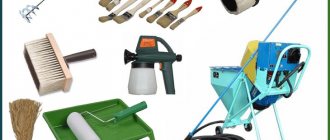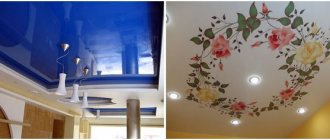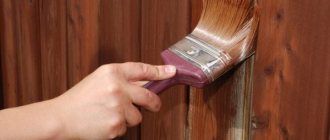Having decided to renovate an apartment or house, everyone understands that the most difficult stage in this matter will be the finishing. Today there are several solutions to this problem, one of which is painting surfaces with water-soluble compounds. This article will discuss how best to do this and which roller for water-based paint should be used.
Why him? Because most walls and ceilings are large, flat surfaces, a paint roller is the most practical tool for them.
Roller with long pile for working with water-based paint
Of course, you can use an ordinary brush, but the strokes from it will be obvious, which, for example, is completely unacceptable for finishing a ceiling. It will appear unevenly colored.
Tip: The brush should be used to paint hard-to-reach places and corners. For example, when Zinga conductive paint is used to protect bathtub legs or chimneys from corrosion.
Paint rollers for water-based paint with different pile lengths
How to choose the right roller
Water-based paints vary in their composition, but the basis for all is water, which also serves as a thinner. In each specific case, the components provide different viscosity (ductility) of the mixture, which affects the choice of tool.
To choose a roller for water-based emulsion, you need to pay attention to several basic parameters:
- Fur coat material. For these purposes, foam rubber, natural or artificial fur, acrylic, velor and other varieties can be used.
- Device size. There are variations in the length of the nozzle, each of which is suitable for a specific task. The width of the pillow is also important.
- Possibility of replacing components. The parts of the tool can be separated, which allows you to change the coat if it becomes unusable or another material is needed.
- Fastening. The bracket can be fixed on one or both sides, which affects the functionality of the roller.
Modern rollers are equipped with a convenient coating fastening system, which makes it easy to change the nozzle
Evaluating all parameters will allow you to paint the surface with high quality and without flaws.
Fur coat material
Paint rollers are usually divided into three main types depending on the material:
- Plastic. These devices are not direct application tools; they are used to give the surface a certain texture.
- Foam rubber. This option is considered one of the most popular, due to its low price and availability. Despite its obvious advantages, it is this variety that has the most disadvantages, especially the rapid loss of its original shape. This tool is great for applying varnish, primer, glue and oil-based paints. When working with water-based emulsion (regardless of its viscosity), many problems arise. Firstly, foam rubber absorbs the coloring composition well. This leads to the fact that when working with the ceiling, most of the solution ends up on the floor, and when painting the walls, difficult-to-remove drips form. Secondly, such a roller contributes to the appearance of bubbles, which give the surface heterogeneity.
A foam paint roller is one of the cheapest and requires some experience.
- Fleecy. This category includes materials whose coat has different lengths: Short pile. This is the best option for substrates that have been thoroughly prepared. If the walls or ceiling have a rough structure, then the lack of paint on the instrument will have to be compensated for by frequent dipping into a container with the composition.
- Average. This size is considered universal, since in this case the paint is absorbed in the required volume and distributed evenly over the surface.
- Long. A large amount of composition and the structure of the pile contribute to obtaining a thick layer and good texture of the coating.
Pile length of fur coats
The disadvantage of this tool is hair loss. If the problem is permanent, then the fur coat needs to be replaced.
Cylinder width and size
The size of the working surface of the roller affects the time and features of the process. The range of cylinder width can vary from 5 to 30 cm, and the diameter - from 4 to 11 cm. The gradation in size is as follows:
- Mini. The width of the tool is no more than 10 cm, and the diameter is up to 3 cm. They are used for work in hard-to-reach places, well suited for small areas.
- Average. Width – up to 15–18 cm with a diameter of up to 6 cm. Standard size, which is used for working on prepared surfaces, including when painting wallpaper.
- Big ones. The width is more than 18 cm and the diameter is more than 6 cm. This is a specialized tool that requires certain skills to work with. Not suitable for low viscosity water emulsion.
On a note! The second type does not allow painting corners, so an additional corner or mini roller is used.
The different widths of the rollers help to perform any task, from painting corners to facade work
There are also corner rollers that have a small cylinder with a diameter of 5 to 12 cm.
Bracket Attachment
The fixation of the bracket affects the order of work. There are two options:
- One side fastening. This is a classic variation that allows you to change hands. Ideal for painting walls. The design can be collapsible or non-demountable.
- Tool with double-sided fixation. Allows you to quickly paint the ceiling and obtain surfaces of excellent quality. This is ensured by a uniform load, which is important when working at height.
We recommend: How to choose a protective mask for painting?
Homemade roller for decorative painting
You can implement your ideas without visiting a hardware store. To do this, you need to make a roller with your own hands, with a little effort and imagination. Let's look at several ways to make decorative rollers yourself:
- Let's take a tool with a foam coat. Next, we wrap the base with ropes, thereby creating a designer accessory. In the future, when working with it, intricate patterns will remain on the surface.
- Using a stationery knife, we cut out any ornament, geometric figure, image of an animal, etc. on a foam rubber (rubber, foam) base. When painted, the picture will be transferred to the wall or ceiling.
Please note: Decorative paint with sand effect: one of the most original textures for interior renovation
An interesting and slightly complicated option using foil and putty. You will need: a thick piece of foil, a tool for squeezing out a pattern (for example, a crochet hook), acrylic putty. Step by step: 1 step. We measure the length of the foil in accordance with the size of the roller. Don’t forget to take into account the layer of putty material. Step 2. We apply the desired design to the base of the foil (polka dots, chamomile, flower, star, etc.). We mint it with a suitable accessory. Step 3. Apply a layer of acrylic putty to the back wall of the prepared material. Step 4 We wrap everything around the instrument’s coat as quickly as possible, preventing premature hardening of the composition. Step 5 We give the structure a cylindrical shape and let it harden. The created ornament will definitely be unique.
Using foil for decorative painting
Polyamide or velor
The advantage of velor fur coats is their resistance to chemical components of paints and varnishes. Rollers can be used with any dyes, including emulsions for painting ceilings.
A tool with a velor coat is convenient because when using it, the paint not only does not splash, but also does not roll off. The only drawback of the devices is the rapid absorption of liquid and the need to repeatedly lower the roller into the paint tray.
The polyamide version of the device is a textile pillow stitched with strong threads. Its main area of application is decorative work, during which you need to ensure that the paint does not splash around.
The paint composition is considered one of the first important factors influencing the choice of roller. There are several types of emulsion paint on sale: silicone, acrylic, mineral and silicate. Acrylic paints are considered the most popular. They contain many acrylic resins and latex. The surface treated with this paint is not exposed to moisture, it is easy to wash without fear that the appearance of the coating will deteriorate.
Silicone compositions include resins of the same name. They easily cope with small cracks no more than 2 mm deep. Often such paints are used for coatings that are constantly exposed to moisture. If you paint a damp surface with an emulsion roller, you will be able to get rid of mold and mildew. The only negative is the high cost of silicone paints.
The choice of roller depends on the type of paint
Water-dispersion mineral paints contain calcium hydroxide or cement. They are ideal for painting walls and ceilings, but the service life of this composition is much shorter than that of other materials. The main component of silicate compositions is colored glass. Paints of this type are widely used for facade work. They fit perfectly on brick and concrete walls, as well as plaster. Throughout its entire service life, the paint reliably protects the surface from bad weather conditions.
Roller arrangement
Therefore, it could be simpler than a paint brush, really nothing, but a roller is not only simpler, but more versatile and more durable. If the paint brush has become unusable, then a sad fate awaits it, but in the roller you can replace the damaged part or, in some types, even restore it . The tool itself consists of:
- yoke, curved handle;
- tube, rod on which the ink part rotates;
- bobbin, rotating cylinder with a fur coat.
In addition to these main parts, the tool can have in its design all kinds of extension cords, moisture removers, and so on. When talking about the sponge bobbin, the differences in the joints between them all depend on the type.
The fur coat can be glued and peeled off from the bobbin, be replaceable or welded together in production. Most often you can find the first two methods; they are the most profitable, because after use you can simply replace the worn sponge with a new one.
How to choose the right roller
Purchasing tools for paint and varnish coatings is a responsible undertaking. Selecting a product is not difficult if you take into account some points:
- you need to calculate the available funds that the owner is willing to spend on the purchase of the roller, as well as on the purchase of cylinders for it;
- it is worth considering the readiness of the surface for processing and coating with the composition;
- It is worth understanding what goal the owner is pursuing, what result he wants to achieve.
After studying and thoroughly considering each issue in the right direction, the buyer will make the final decision and buy the device that is useful specifically for his type of work. In the process of painting surfaces, you must follow operating and safety rules; it is recommended to wear protective gloves and a mask. General recommendations when selecting a design for a water-based emulsion look like this:
- The owner will decide for himself which roller is best to paint walls with water-based paint. But before buying it, you need to thoroughly study it in the store. The buyer is not insured against low-quality purchases; the goods often turn out to be defective or faulty.
- The first thing to consider is the integrity and quality of the pad. It should be uniform, without protruding threads or fibers. The handle is accepted only as a whole, without flaws. If the pad is of good quality, the seams on it will not be noticeable.
- The roller must be held firmly in the palm of your hand and released. A good pad will quickly regain its shape.
- It is recommended to pull out a little lint. They should not end up in the buyer's hand. Otherwise it's fake.
- An important criterion is to choose the right dishes for the roller. It is recommended to purchase a special container that will allow you to achieve maximum coloring of the surface. There is no need to use a bucket as the result will be disappointing. To improve the appearance of the ceiling, it is recommended to purchase a special telescopic pipe; it will avoid the use of scaffolding and stepladders. It will help you get to the desired height.
- If the seam on the pillow is too noticeable, then it is better to put such a roller back on the shelf, since it will leave unsightly stripes when finishing.
Pay attention to: Design and types of spray guns for water-based paint
The user pays attention to the handle. For comfortable use, it should be from 30 to 50 cm in length. A high-quality design has the following properties:
- distribution of the composition over the surface to be painted in a thin layer;
- good paint absorption - no excess;
- the ability to cover a larger area when finishing;
- Due to the versatility of the roller drum, you can change the size of the fibers.
The cylinder can also be different, it affects the surface area being processed:
- Mini ones range from 3 to 9 cm in diameter and reach 15 cm in length. A device with such a cylinder is used for painting a small area.
- Midi are comfortable rollers of medium size. The diameter of the cylinder is 9 cm, and the length reaches 20 cm. This variety is suitable for painting the inside of a house - for walls, ceilings, facades.
- Maxi is used for finishing work on a house from the street, that is, external processing. The cylinder is 8 cm in diameter, 30 cm in length.
The size of the device is selected based on the area being treated. If the repair is small, then you need to purchase an option with a mini-cylinder; to paint a large wall, you should use a maxi-roller.
Important! Some users believe that if you need to paint a wall in a room at home, it is wiser to use a large roller. But this is a misconception. During the interior finishing period, the fixture increases in weight as it absorbs paint. And the composition spreads and splashes in different directions. The device is perfect for treating the facade of a house - the paint dries quickly.
The nozzle itself has several types of fastenings, depending on which the desired device is selected:
- A tool with a rigid mount is extremely difficult to disassemble, in most models it is even impossible. The roller can be thrown away after the fur coat becomes unusable.
- If the device is equipped with a coupling, then during the wear process the coat is removed and a replacement is installed.
- Frame type - such a system involves repeated use of the device without a core.
We recommend: How to make an airbrush at home
How to determine the length of the pile
The quality of the work performed depends on the correctly chosen length of the fur coat pile. Depending on the structure of the surface to be painted, rollers with different pile lengths are used.
- Up to 5 mm. – for painting smooth surfaces (mainly varnishing).
- 5–10 mm. – for painting ceilings and putty walls.
- 5–20 mm. Mainly used for painting concrete surfaces, unsanded wood or rough plaster.
- 20–30 mm. Coats with a long pile length are used to paint brick, concrete surfaces, walls with relief plaster, strong porosity and roughness.
Smooth, smooth walls do not require much effort to paint; a short pile will be enough. Another thing is a surface with many irregularities and roughness; to finish them, it is advisable to choose a roller with long pile. The variety of combinations of options for these components makes it possible to choose the appropriate tool for use in painting work.
How to choose?
The choice of tool remains mainly with the performer of the work. And yet there are fewer and fewer adherents of brushes. Painting almost any surface of the room is faster and more convenient with a roller, which is quite easy to find in modern hardware stores. Using a roller, the paint spreads and is applied more evenly to the surface. In addition, the tool for working with rollers is more technologically advanced and practical for use by beginners who do not understand all the intricacies of repair work.
Additionally, it is worth noting that paint consumption when working with a roller is also reduced due to the lack of the ability of the brush to absorb paint, which means that some of it is splashed around - this will inevitably lead to overconsumption of the paint composition. This will not happen with a properly selected roller - there will be a clear saving in material.
It is better to leave brushes to the use of severe and experienced painters or to paint some specific things with them, and for indoors it is most economical to use rollers. For hard-to-reach places, of course, you can’t do without a brush, but for typical room painting (even using a stencil), a roller is the ideal choice.
Another option for a novice painter is a spray gun, but you can hardly find a stable working model for one repair, and buying a professional option for 2-3 rooms definitely doesn’t make sense.
But you can try renting a spray gun or spray gun - such a pleasure is inexpensive and affordable for an ordinary builder.
Types of emulsion paint
Before you get acquainted with the features of choosing rollers for painting, you need to understand what emulsion paints are. It is worth noting that the type of composition determines which tool will be used in the coloring process.
Today there are four types of emulsion paints. The difference between all options is the presence of polymer in the composition.
- One of the most popular types are acrylic paints , which are used by both experienced and novice artists. It is worth noting that these compositions are suitable for different types of surfaces, which can be attributed to their main advantage. The main component in these paints is acrylic resin. It is this substance that ensures the high performance qualities of the composition.
- The following types are silicone water-based paints . This is an ideal option for rooms where the humidity level is quite high. The predominant component in paints is silicone resin. It is worth noting that these options are ideal for masking minor defects on ceilings.
- No less versatile are silicate paints . They are based on liquid glass, supplemented with various color pigments. The main distinguishing features of these paints are durability and stability.
- The last type is mineral paints . During the production process, slaked lime is added to the compositions. Manufacturers often replace this option with cement. The versatility of mineral paints lies in the fact that they are used both for walls and for painting ceilings. Most often they are used for painting work on concrete and brick surfaces.
Recommendations for selection depending on the type of paint
Let's look at which rollers should be used depending on the type of paint composition.
Water-based
Any type of roller is suitable for working with water-based paint, but you should take into account the characteristics of the base on which the paint is applied. It is better to use fur skins for the ceiling, and foam rubber and velor for the walls. We wrote about painting with water-based emulsion here.
Acrylic
Just like with water-based paint, any roller skins are suitable for acrylic paint.
Alkyd
The rather aggressive composition of alkyd paints is not suitable for foam rollers. In this case, it is better to choose a fur or velor roller.
Oil paint and enamel
These coloring compounds, like alkyd ones, are considered aggressive, and therefore, to paint the surface with oil paint or enamel, you need to choose durable velor rollers.
How to choose a roller for painting walls
Painting is the final stage of finishing. Which roller is best for painting walls over a large area? How much time will be spent on the entire process and the quality of the final result depends on the correct solution to this issue.
The market offers a large selection of tools for painters. You should choose time-tested options. A roller is one of them, allowing you to quickly apply paint in an even layer. Well-painted surfaces give the room an aesthetic appearance.
What types of rollers are there?
Today the market offers consumers a large number of different types, differing in purpose. How to choose a roller for painting walls is greatly facilitated by the presence of a clear classification.
It is based on the following characteristic features:
- type of material for the paint roller surface;
- its texture;
- tool dimensions;
- forms.
High quality tools are marked on the packaging with Latin letters. The manufacturer thus emphasizes its class by indicating the materials used for its production.
| artificial | RE | faux fur, foam rubber (regular, reinforced) |
| RA | perlon, nylon | |
| RS | polyacrylic derivatives | |
| natural | N | rubber, natural fur (e.g. fox, goat, sheep, llama), felt (thick, thin, medium) |
Among artificial ones, the PE type is the softest.
Fur roller is the most expensive
Products made from natural fur have the highest price. Prices for felt and rubber types are at the level of artificial rollers. You should choose them according to your needs, carefully examining them.
In practice, it is recommended to use a tool with a natural finish when painting expensive surfaces or using expensive paint. Natural ones have better contact with the surface.
Soft faux fur is used for painting a wide variety of surfaces, while natural wool is usually used for expensive ones. The choice depends on your needs. Simpler cases involve the use of less expensive devices.
The above division contains additional subspecies. Rollers covered with natural or artificial fur are divided into ordinary ones for the floor and corners.
Conventional fur is successfully used for walls with minor defects (irregularities). The floor subtype is intended only for horizontal surfaces, because paint runs off strongly.
Rollers for painting corners differ only in shape. This is done for ease of use. Foam rubber is used when working with adhesive compositions.
We recommend: What types of hand-held spray guns are there?
Choosing a roller for walls
For smooth surfaces, use rollers with polyamide bristles
The choice depends on the paints and adhesive solutions used. To ensure that the chosen roller lasts a long time, it is better to rely on the advice of experts:
- medium-thick foam roller - the best option for water-based paints, liquid adhesives, primers;
- fur with short, medium pile - used on smooth walls;
- The polyamide thread base is perfect for smooth surfaces;
- Rubber and foam bases are suitable for textured painting;
- velor ones are used for all types of coloring compositions.
When choosing, the width of the tool is also taken into account. For an apartment, a 30 cm sample is enough. You should also purchase accessories: additional attachments, an extension handle, a grater (removes drops).
Preparing walls for painting, painting with a roller
Prepare the base before painting
To use a roller to paint walls, you first need to prepare the room. It is necessary to remove curtains and furniture (or move them, cover them with film or special covers).
If necessary, cover the floor with cardboard paper, cover the doors and windows with plastic film (you can use cloth, but there is a possibility of leakage), and cover the baseboard with paper tape.
Preparing the walls comes down to a number of operations:
- after turning off the power supply, remove the covers from switches and sockets;
- Cover the remaining “insides” with masking tape;
- if necessary, remove heating radiators;
- cleaning and making the surface smooth: removing wallpaper (if any), hiding defects with putty, sanding dried walls.
Pallet for paint
The work requires the availability of basic and auxiliary equipment:
- screwdriver, knife, paint tray;
- set of rollers, sanding accessories.
After all the preparations, having chosen a roller for the walls, you can start working:
- the tray is filled with a small amount of dye;
- the roller is dipped and rolled out to remove excess and distribute the coloring matter evenly over its surface;
- painting begins from the corner, then spreads in any convenient direction;
- to avoid the appearance of streaks, move the tool smoothly, without pressure, from top to bottom and back;
- The corners are painted with a brush. For information on the types of rollers, watch this video:
The remaining layers are applied only after the first has dried.
Roller care
Rinse the instrument with water or solvent
Upon completion of all work, he needs to be cleaned of used dyes, varnishes, and adhesives. After which it should be stored. In order for the tool to serve for a long time, it is necessary:
- Wash water-based paints, wallpaper paste with clean water and dry without squeezing;
- Solvents are used to clean varnishes and acrylic paints immediately after completing work so that the surface being treated does not dry out;
- storage should be in a dry place. For more information on how to care for your instrument, watch this video:
The widespread use of rollers is due to their practicality. Being on the floor, you can complete the treatment of areas in a short time. The disadvantages of this method are the impossibility of normal painting of corners and joints and the absorption of large volumes of paint by some working coatings (require squeezing).
Which roller is better to paint the ceiling with water-based, water-dispersion paint?
The choice of pile length and material largely depends on practical experience, the degree of paint dilution and the quality of the surface. For example, you can paint drywall material relatively quickly with a roller with a built-in container.
The viscosity of the water dispersion is low, so the painting process will be quite fast, although it can only be recommended for smooth surfaces with slight roughness.
Which roller to paint the ceiling with acrylic paint
It is not advisable to use foam rubber, fiber, velor or fur for water-based compositions. If you want to paint with high quality, but not too quickly, then the best option for painting the ceiling with water-based paint would be a thread roller, photo.
Any increase in the speed of movement of the tool will inevitably lead to leakage of the nozzle, the liquid will begin to splash, and some will flow down the handle. If you need to paint with acrylic paint at high speed, you will need to take care of a special protective attachment for the tool. An option on how to paint a ceiling with water-based paint with a roller, in the video:
Roller for latex paint for ceiling
The viscosity of latex is noticeably higher than conventional water-based emulsion, so the ceiling surface can be painted with a fur or long-pile nozzle without much difficulty. Latex paint, even in one layer, gives a fairly thick coating, so if the pile is worn unevenly, a background pattern or mark may appear.
Criterias of choice
Many people wonder: which roller to choose for painting the ceiling or walls. There are eight main aspects to consider when choosing a roller:
- Reliability of pile fastening. You can try pulling the lint or threads. If they are not left in your hands, the tool deserves attention. This is important to eliminate lint residue on the walls.
- Natural paint coats are considered reliable and environmentally friendly. However, such models are more expensive than artificial analogues.
- Roller diameter for acrylic paint. Larger cylinder sizes are used to complete work in the shortest possible time, as more paint is captured on it. However, one can argue about the convenience of such a model for the hand. For some people they are heavy, so lighter options are preferred.
- Pile length. The longest one is used for uneven relief surfaces, as it paints better. For smooth walls, it is better to choose a short pile to avoid streaks on the surface. This aspect is important when using paints of a translucent consistency.
- Handle length. A roller with a specific handle is selected for all surfaces. Painting walls under the ceiling is impossible without a roller with a telescopic handle (up to 2 meters). And for low structures that do not exceed the height of a person, the classic version with a short handle is sufficient. For convenience, a roller with replaceable handles is purchased.
- You also need a roller for painting white wallpaper, which differs in design and material from which the roller is made.
- It is important to pay attention to the seam. It should not be convex, as it slows down the movement of the roller and smears the paint.
- If you plan to paint in different shades, it is recommended to choose a tool with several interchangeable rollers.
Don't forget to purchase a cuvette. This small trough allows you to apply paint evenly and remove excess paint from the roller. It is reusable, so it will be useful for further repairs.
Dimensions
The rollers differ not only in design, but also in size. The instruments are classified according to their sizes:
- mini rollers. They are designed for applying paint or glue to small areas, corners, or for working with stencils. Suitable for painting pipes;
- midi are suitable for working with polyurethane, polyamide or alkyd paint. They are suitable for painting doors, floors and walls, which is why this roller is popular among professional painters.
There are also separate rollers for working with bitumen and structural paint.
Foam rubber
The cheapest option, suitable for water-based paints for interior work. Its main drawback is its low resistance to aggressive compounds. The foam roller is not suitable for oil and alkyd paints.
Velours
The velor roller is chosen by those who value quality. It allows you to create smooth surfaces if the painter is professionally trained. If there is none, it’s worth practicing, as all the defects will stand out.
Fur
Fur varieties are used for applying enamel, oil, latex paints and silicates. The shorter the pile of such a fur coat, the smoother the surface will be. These rollers are considered classic, since their history goes back to the past, when our grandparents painted fences and walls of houses with them.
Polyamide thread
Rollers with threads instead of a coat allow you to apply paint quickly, but not too carefully. In this case, the movements should not be sharp, since paint tends to splash from the roller.
Design features
Paint rollers have a fairly simple design. They consist of the following elements:
- The clasp is a bracket on which a roller with a fur coat is attached. It has a curved shape. A comfortable handle is installed at the end so that the tool fits comfortably in your hand.
- Lever. It is made of plastic, wood or rubberized material. Special depressions are made on it, repeating the shape of the fingers. This allows you not to be afraid that the roller will slip out of your hand.
- Video clip. It is a cylinder that rotates freely on a clasp. It is made of plastic or metal.
- Coat. Fits over the roller. It can be made of foam rubber, velor or faux fur with different pile lengths. This part of the roller is intended for applying paint.
Thanks to this design, the paint roller has advantages over other tools:
- productivity and speed of painting increases;
- it is permissible to use any type of paint;
- no hairs or other traces of the tool remain on the applied layer;
- paint is consumed less;
- There are no splashes or smudges during painting.
Only high-quality products have these advantages. Previously, in our country, rollers were produced according to GOST. Today, construction stores sell mainly imported goods.
Material for working part
Depending on what material the working part of the roller is covered with, it can be of the following types:
- Polyamide - made of artificial fiber. This coating is characterized by increased wear resistance and tolerates chemical exposure well. As a rule, such rollers are used for water-dispersed paint. The length of the villi can be 0.8-2 cm.
- Acrylic is made from a synthetic fiber that resembles wool. This coating reduces paint splashing during operation, as it has a very dense pile. It is worth considering that a roller with such a working part is not suitable for applying paint that contains aggressive components.
- A polyester roller that looks like padding polyester. This roller coating absorbs paint very well and holds it, while being low in cost. One of the big advantages is that it does not leave lint during operation, but this material is not durable in use.
- Fur can be made from natural or artificial fur. Natural is made from sheep wool and is suitable for coloring materials without lime components. A faux fur roller is suitable for painting with any material and is considered universal in purpose.
- Velor is made of wool and synthetic fiber and tolerates solvents well. This roller leaves no marks and is designed for painting smooth surfaces.
- The foam roller is designed for painting with water-based varnishes. When finished, small air bubbles are left behind, giving the surface a textured appearance.
- Felt is considered an environmentally friendly material. A felt coat roller is perfect for painting with any materials.
- Rubber is used to remove air when wallpapering and for applying texture patterns.
Microfiber absorbs and releases material well. This type of roller is suitable for smooth or slightly rough surfaces, for priming.
The roller roller can be made of plastic, aluminum, or wood. The most popular ones are made of plastic, since the material is cheap and easy to manufacture.











